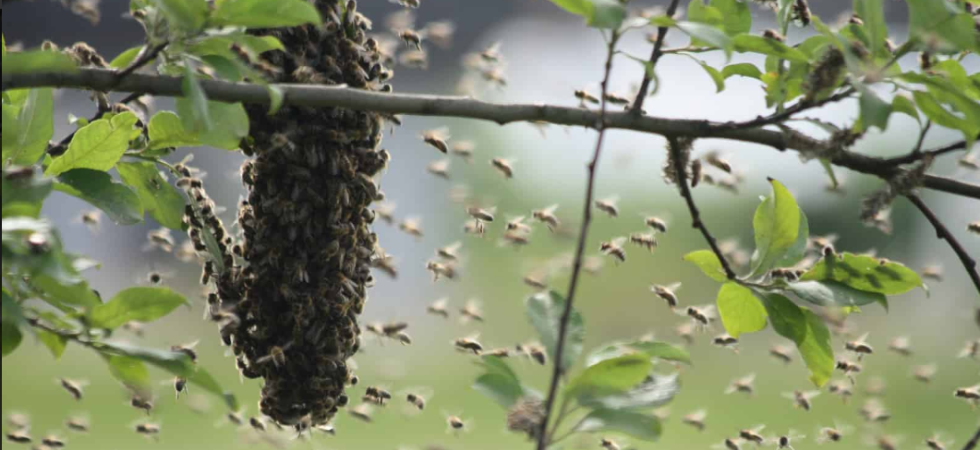|
BY VAL VIVIAN-GRIFFTHS Beekeeping is a very skilful art and has to be learnt by experience. I am not going to try and tell anyone what to do but hope that the following will help. I make mistakes every season but I’m sure I make a lot fewer now than when I first took up beekeeping. THE BEES WILL ALWAYS SECOND GUESS YOU
Every season is different and at times they will cause great difficulty with swarming. YOU ARE NOT THE ONLY BEEKEEPER HAVING PROBLEMS WITH SWARMING You may read or be told that swarming only occurs with an older queen and/or congested hive but this is not my experience. Young queens with plenty of space may also swarm. Due to an early spring the swarming season may start early and continue for a long time. A ‘SWARM’ MAY SWARM AGAIN LATER IN THE SEASON During a normal inspection you find the bees have begun to raise queen cups. Do not panic! Check the cells and if they are empty ignore them. THE BEES “PRACTICE” BUILDING QUEEN CELLS JUST TO CONFUSE THE BEEKEEPER If you find queen cells which contain royal jelly and larvae you need to take action, do not just break down the cells. If they are empty then you can leave them. THE BEES ARE TELLING YOU THEY ARE GOING TO SWARM AND NOTHING WILL STOP THEM You now need to bring your preferred method of swarm control into action. Think about this before the season or before you get your bees. PLAN FOR SWARMING AND HAVE EQUIPMENT READY The method I use when I find “charged” queen cells is to find the queen and put that frame of brood plus one or two others, depending on the colony strength, into a nucleus, plus two or three good shakes of bees, filling the rest of the space with frames of foundation or drawn comb if you have it. Stuff the entrance with damp grass and move the nucleus to a new place. You now have the queen, plenty of nurse bees and brood. Most of the flying bees will return to the parent colony. The grass will stop the bees pouring out and the nucleus will retain a percentage of older bees. DO NOT FEED THIS NUCLEUS FOR A COUPLE OF DAYS Flying bees returning to the parent hive will communicate the location of the bounty and initiate robbing. NOT ALL QUEEN CELLS ARE CREATED EQUAL In the parent colony carefully select the queen cell you want to leave. It needs to be in a good position, with plenty of royal jelly and a larva so small you can only just see it. Brush the bees off this frame to check there are no further queen cells. Knock down the rest of the queen cells on the other frames, shaking the bees off so that you can see the unwanted queen cells. Fill the hive with frames of foundation this will give any young bees something to do as there will be a reduction in brood to feed before the new queen comes into lay. BEES HIDE QUEEN CELLS AND EVEN AN EXPERIENCED BEEKEEPER CAN MISS THEM Five days later inspect the parent colony for further emergency queen cells and knock those down being very careful with the original saved queen cell. BEES WILL PANIC WHEN YOU REMOVE THE QUEEN AND WILL RAISE EMERGENCY CELLS Do not harvest these emergency cells. If you want to harvest cells use the first batch of cells, swarm cells. Swarm cells have been raised when the bees have decided to swarm, emergency cells when they are forced. QUEENS FROM SWARM CELLS ARE BETTER THAN THOSE FROM EMERGENCY CELLS Now leave the parent colony alone for at least four weeks to allow the new queen to emerge, mate and to start laying eggs. BEEKEEPERS DO MORE DAMAGE AT THIS STAGE THAN AT ANY OTHER TIME If after all this work and at least six weeks your parent colony proves queenless just merge the nucleus and the old queen back together. THE TIME THE QUEEN TAKES TO MATE ALWAYS TAKES LONGER THAT YOU THINK AND IS VERY WEATHER DEPENDANT Remember, bees are wild creatures and they cannot be made to do anything. It is up to the beekeeper to work with the bees and listen to what they are telling you. Comments are closed.
|
AuthorArticles are written by our members. If you would like to write one please get in touch. Archives
October 2017
|
